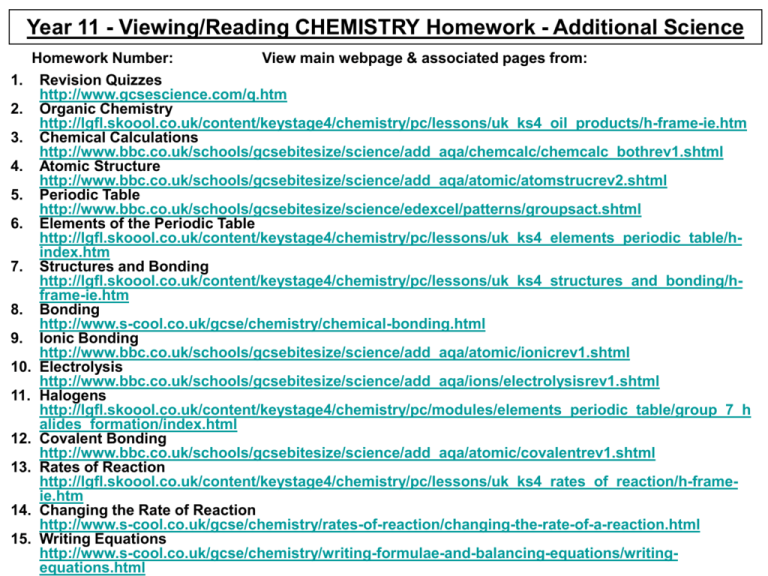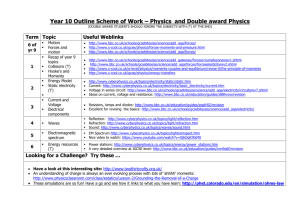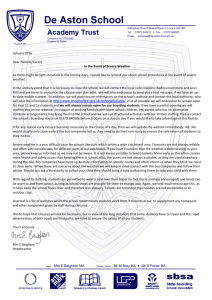Borrow Edexcel GCSE Additional Science Active Book CDRom from
advertisement

Year 11 - Viewing/Reading CHEMISTRY Homework - Additional Science Homework Number: View main webpage & associated pages from: 1. Revision Quizzes http://www.gcsescience.com/q.htm 2. Organic Chemistry http://lgfl.skoool.co.uk/content/keystage4/chemistry/pc/lessons/uk_ks4_oil_products/h-frame-ie.htm 3. Chemical Calculations http://www.bbc.co.uk/schools/gcsebitesize/science/add_aqa/chemcalc/chemcalc_bothrev1.shtml 4. Atomic Structure http://www.bbc.co.uk/schools/gcsebitesize/science/add_aqa/atomic/atomstrucrev2.shtml 5. Periodic Table http://www.bbc.co.uk/schools/gcsebitesize/science/edexcel/patterns/groupsact.shtml 6. Elements of the Periodic Table http://lgfl.skoool.co.uk/content/keystage4/chemistry/pc/lessons/uk_ks4_elements_periodic_table/hindex.htm 7. Structures and Bonding http://lgfl.skoool.co.uk/content/keystage4/chemistry/pc/lessons/uk_ks4_structures_and_bonding/hframe-ie.htm 8. Bonding http://www.s-cool.co.uk/gcse/chemistry/chemical-bonding.html 9. Ionic Bonding http://www.bbc.co.uk/schools/gcsebitesize/science/add_aqa/atomic/ionicrev1.shtml 10. Electrolysis http://www.bbc.co.uk/schools/gcsebitesize/science/add_aqa/ions/electrolysisrev1.shtml 11. Halogens http://lgfl.skoool.co.uk/content/keystage4/chemistry/pc/modules/elements_periodic_table/group_7_h alides_formation/index.html 12. Covalent Bonding http://www.bbc.co.uk/schools/gcsebitesize/science/add_aqa/atomic/covalentrev1.shtml 13. Rates of Reaction http://lgfl.skoool.co.uk/content/keystage4/chemistry/pc/lessons/uk_ks4_rates_of_reaction/h-frameie.htm 14. Changing the Rate of Reaction http://www.s-cool.co.uk/gcse/chemistry/rates-of-reaction/changing-the-rate-of-a-reaction.html 15. Writing Equations http://www.s-cool.co.uk/gcse/chemistry/writing-formulae-and-balancing-equations/writingequations.html Borrow Edexcel GCSE Additional Science Active Book CDRom from MMRC. Load ‘Active Book’ onto your PC at home. Remove from your PC when you have completed your GCSE. Homework Number: read pages: Synthesis 16. The basics of organic chemistry 17. A cracking lesson 18. Introduction to polymers 19. Formation and uses of polymers 20. It’s all fat, but does it make you fat? 21. Making new chemicals safely 22. Synthesis in action 23. Chemical calculations 24. Using chemical reactions 25. Formulae and percentage yields p105-107 .. p108-109 .. p110-111 .. p112-113 .. P114-115 .. P116-117 .. P118-119 .. P120-121 .. P122-123 .. P124-125 .. .. .. .. .. .. .. .. .. .. .. .. .. .. .. .. .. .. .. .. .. .. .. .. .. .. .. .. .. .. .. .. □ .. □ .. □ .. □ .. □ .. □ .. □ .. □ .. □ .. □ In your element 26. 27. 28. 29. 30. 31. 32. 33. 34. 35. P129-131 .. P132-133 .. P134-135 .. P136-137 .. P138-139 .. P140-141 .. P142-143 .. P144-145 .. P146-147 .. P148-149 .. .. .. .. .. .. .. .. .. .. .. .. .. .. .. .. .. .. .. .. .. .. .. .. .. .. .. .. .. .. .. .. □ .. □ .. □ .. □ .. □ .. □ .. □ .. □ .. □ .. □ Explaining the properties of metals Elements and their parts Elements in the Periodic Table Ions and iconic bonding Ions and giant structures Electrolysis of salts and solutions Isotopes Reactions of alkali metals Reactivity of the halogens The noble gases done? Borrow Edexcel GCSE Additional Science Active Book CD Rom from MMRC. Load ‘Active Book’ onto your PC at home. Remove from your PC when you have completed your GCSE. Homework Number: read pages: done? Chemical structures 36. 37. 38. 39. 40. 41. 42. 43. 44. 45. Covalent bonding Giant covalent structures The different forms of carbon Simple covalent structures Physical properties of the halogens Giant metallic structures Scientific discoveries by chance Molecular models Homeopathic medicine Chemical based therapies p153-155 .. p156-157 .. p158-159 .. p160-161 .. p162-163 .. p164-165 .. p166-167 .. p168-169 .. p170-171 .. p172-173 .. .. .. .. .. .. .. .. .. .. .. .. .. .. .. .. .. .. .. .. .. .. .. .. .. .. .. .. .. .. .. .. □ .. □ .. □ .. □ .. □ .. □ .. □ .. □ .. □ .. □ How fast? How furious? 46. 47. 48. 49. 50. 51. 52. 53. 54. 55. What are chemical reactions? Energy in reactions Collision theory and reaction rates What affects reaction rates Catalysts and reaction rates Data-logging with reaction rates Enzymes – the biological catalysts Reversible reactions Ammonia production p194-195 .. Fertilisers – artificial or organic? P177-179 .. p180-181 .. p182-183 .. p184-185 .. p186-187 .. p188-189 .. p190-191 .. p192-193 .. .. .. .. .. □ p196-197 .. .. .. .. .. .. .. .. .. .. .. .. .. .. .. .. .. .. .. .. .. .. .. .. .. .. □ .. □ .. □ .. □ .. □ .. □ .. □ .. □ .. .. .. .. □





